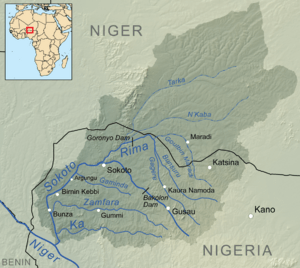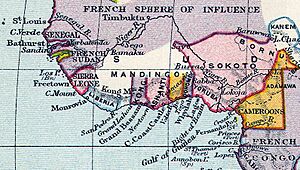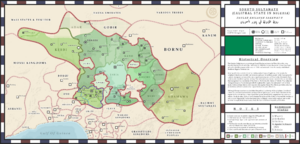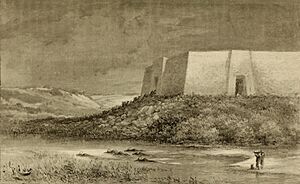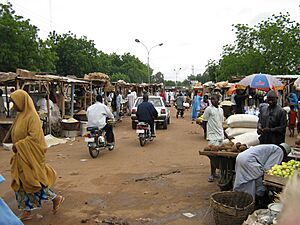Sokoto facts for kids
Quick facts for kids
Sokoto
|
|
|---|---|
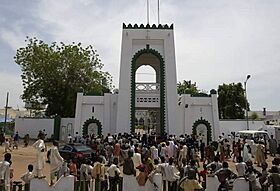
Sultan's Place
|
|
| Country | |
| State | Sokoto State |
| Population
(2006 census)
|
|
| • Total | 427,760 |
| GDP (PPP, 2015 int. Dollar) | |
| • Year | 2023 |
| • Total | $3,3 billion |
| • Per capita | $4,600 |
| Climate | BSh |
Sokoto is a large city in north-western Nigeria. It is located where the Sokoto River and the Rima River meet. This meeting point is called a confluence. In 2006, the city had over 427,760 people. Today, Sokoto is the capital of Sokoto State. It used to be the capital of the north-western states.
Sokoto is famous for trading animal skins, like sheepskins and goatskins. They also trade leather crafts, which are sent to other countries. Other important goods include kola nuts. The city was once the center of the Sokoto Caliphate. Most people in Sokoto are Muslim. It is an important place for Islamic learning in Nigeria. The Sultan of Sokoto is the main spiritual leader for Nigerian Muslims.
Contents
What Does the Name Sokoto Mean?
The name Sokoto comes from the Arabic word sooq. This word means 'market' in English. People also call it Sakkwato, Birnin Shaihu da Bello. This means "Sokoto, Capital of Shaihu and Bello".
What is Sokoto's Climate Like?
Sokoto has a hot semi-arid climate. This means it is very dry and hot. It is located in the dry Sahel region. The city is surrounded by sandy savannah and small hills.
- Temperatures: The average temperature is about 28.3°C (82.9°F). This makes Sokoto one of Nigeria's hottest cities. However, daytime temperatures are usually below 40°C (104°F). The dry air makes the heat easier to handle. The hottest months are February to April, when temperatures can go above 40°C. The highest temperature ever recorded was 45°C (113°F).
- Rainy Season: The rainy season lasts from June to October. Showers happen daily but usually do not last long.
- Dry Season: From late October to February, it is the 'cold season'. During this time, the harmattan wind blows dust from the Sahara Desert. This dust makes the sunlight dimmer and lowers temperatures.
The Sokoto River and Rima River are very important for farming. Their floodplains have rich soil. Farmers grow crops like millet, guinea corn, and beans. They also grow maize, rice, and sesame. Vegetables like onions, tomatoes, and cabbage are also grown. Sokoto is a major producer of onions in Nigeria. The area is a savannah grassland. This is good for growing grains and raising animals. The dry season is from October to April or June. The wet season is from May to September or October. The harmattan wind brings dry, cold, and dusty weather from November to February.
| Climate data for Sokoto (1981–2010) | |||||||||||||
|---|---|---|---|---|---|---|---|---|---|---|---|---|---|
| Month | Jan | Feb | Mar | Apr | May | Jun | Jul | Aug | Sep | Oct | Nov | Dec | Year |
| Mean daily maximum °C (°F) | 32.1 (89.8) |
34.8 (94.6) |
38.6 (101.5) |
40.6 (105.1) |
39.0 (102.2) |
36.2 (97.2) |
32.8 (91.0) |
31.3 (88.3) |
32.8 (91.0) |
36.0 (96.8) |
36.1 (97.0) |
32.9 (91.2) |
35.3 (95.5) |
| Daily mean °C (°F) | 24.5 (76.1) |
27.1 (80.8) |
31.2 (88.2) |
33.7 (92.7) |
33.1 (91.6) |
30.9 (87.6) |
28.2 (82.8) |
27.2 (81.0) |
28.0 (82.4) |
29.7 (85.5) |
28.3 (82.9) |
25.3 (77.5) |
28.9 (84.1) |
| Mean daily minimum °C (°F) | 16.9 (62.4) |
19.4 (66.9) |
23.8 (74.8) |
26.9 (80.4) |
27.3 (81.1) |
25.6 (78.1) |
23.6 (74.5) |
23.1 (73.6) |
23.2 (73.8) |
23.4 (74.1) |
20.5 (68.9) |
17.7 (63.9) |
22.6 (72.7) |
| Average rainfall mm (inches) | 0.0 (0.0) |
0.1 (0.00) |
1.5 (0.06) |
4.8 (0.19) |
46.5 (1.83) |
80.0 (3.15) |
186.6 (7.35) |
200.5 (7.89) |
109.8 (4.32) |
17.2 (0.68) |
0.0 (0.0) |
0.0 (0.0) |
647 (25.47) |
| Average rainy days (≥ 0.2 mm) | 0 | 0 | 0 | 1 | 4 | 7 | 11 | 14 | 8 | 2 | 0 | 0 | 47 |
| Average relative humidity (%) | 24 | 19 | 21 | 34 | 50 | 62 | 76 | 83 | 80 | 64 | 36 | 27 | 48 |
| Mean monthly sunshine hours | 288.3 | 268.4 | 275.9 | 255.0 | 272.8 | 279.0 | 229.4 | 186.0 | 237.0 | 303.8 | 300.0 | 300.7 | 3,196.3 |
| Mean daily sunshine hours | 9.3 | 9.5 | 8.9 | 8.5 | 8.8 | 9.3 | 7.4 | 6.0 | 7.9 | 9.8 | 10.0 | 9.7 | 8.8 |
| Source 1: World Meteorological Organization | |||||||||||||
| Source 2: Deutscher Wetterdienst (humidity, 1951–1965 and sun, 1952–1961) | |||||||||||||
A Brief History of Sokoto
Sokoto was first used in 1804 by Usman dan Fodio. It was a meeting place for important leaders. Later, his son Muhammad Bello used it as a base for attacks. Some believe the area was called Sokoto as early as the 1600s.
The city was officially founded in 1809 as a military camp. After Usman dan Fodio died, it became the capital of the caliphate. In the 1820s, Sokoto was very rich and powerful. It received money from all its controlled areas. An explorer named Hugh Clapperton visited in 1827. He was very impressed by the city's wealth.
Clapperton noted that the rivers were more important than long-distance trade. But he also said that trading was difficult because the surrounding areas were not peaceful. By 1853, when explorer Heinrich Barth arrived, Sokoto was less populated. It looked quite old and run down. Barth estimated its population at only 20,000–22,000 people. However, the market was still busy.
Sokoto was a strong location for a city. It had steep slopes on three sides. A small valley protected it from attacks. The city controlled the wide lowlands where the Rima and Sokoto rivers meet. It was also a meeting point for roads from different kingdoms.
In the early 1800s, Sokoto was divided into sections called wards. These included Magajin Gari, Waziri, and Sarkin Musulmi wards. These wards were small and surrounded by a wall. Inside the wall were mosques, the Sultan's Palace, and other buildings. In 1818, the wall was made bigger. It had gates like Kofar-Kade and Kofar-Kware.
The area where Sokoto is now was home to many old kingdoms. These included the Gobir and Kebbi kingdoms. It also became the center of the famous caliphate. In 1903, the British took control of the caliphate. Its parts became separate and joined the government of Northern Nigeria.
In 1967, states were created in Nigeria. Sokoto became the capital of the North-Western State. Later, in 1976, Sokoto State was formed. In 1991 and 1996, Kebbi and Zamfara states were created from Sokoto State. So, Sokoto city has been a capital for many governments since 1809.
People and Culture in Sokoto
Sokoto State has about 3.7 million people. Most of them belong to two main groups: the Fulani and the Hausa. Sokoto city itself has about 2.5 million people. There are also smaller groups like the Zabarmawa and Tuareg.
Most people in Sokoto speak Hausa. The Fulani also speak Fulfulde. The Hausa people in the state include groups like Gobirawa and Zamfarawa. The Fulani have two main types: town Fulani and nomads. The Torankawa are a special group of Fulani. They are the ruling class since 1804.
The culture in Sokoto is very similar across the state. Most people are Muslim. Their clothing styles come from Islamic traditions. Two major festivals are celebrated each year. These are Eid-el-Fitri and Eid-el-Kabir. Eid-el-Fitri marks the end of the Ramadan fast. Eid-el-Kabir involves sacrificing rams. This remembers a story about the Islamic prophet Ibrahim.
Traditional sports are popular. These include wrestling (Kokawa) and boxing (Dambe). The Fulani enjoy their own sports called Sharo and Doro. Important visitors often see a grand or mini durbar. This event features parades of horses and camels. Riders wear colorful traditional military and cultural clothes.
Economic Activities in Sokoto
Most people in Sokoto (over 80%) work in agriculture. They grow crops like millet, guinea corn, and maize for food. They also grow wheat, cotton, and vegetables to sell. Local crafts are also important. These include blacksmithing, weaving, dyeing, and leather work. Sokoto is also a place where a lot of fish are caught. Many people living near the rivers work as fishermen.
Sokoto has many natural resources. Industries can use cotton, groundnut, and rice as raw materials. Large farms can use water from dams and lakes for irrigation. The state also has many minerals. These include kaolin, gypsum, and limestone. These minerals can be used to create new industries.
The area is good for raising animals. Sokoto is second in Nigeria for the number of livestock. All these resources mean there are good chances for businesses. Especially for industries that process farm products.
How People Travel in Sokoto
Sokoto does not have a public transport system like buses or trains. People mostly travel by mopeds. These act like single-person taxis. Tricycles also carry people, often more than one at a time. Both are cheap ways to get around. Buses and taxis are mainly used for travel between cities.
An interesting fact is that there is an all-female garage in Sokoto city. It trains young women to fix vehicles. This project helps empower girls and women. It is supported by local Islamic leaders. Sokoto also has an international airport. It has flights to major Nigerian cities like Abuja, Kano, and Lagos.
City Development and Growth
Cities have a long history in Hausaland. Many areas grew from small villages into larger towns. The jihad (holy war) led by Shehu Usmanu Danfodiyo sped up this process. New towns appeared, and older ones grew quickly. Some became centers for trade. Others became capitals and centers for both government and business.
Sokoto city was planned by Muhammad Bello. He was the son of Shehu Usmanu Danfodiyo. Bello was a strong leader and war commander. He designed Sokoto city on paper before it was built. His design included roads, bridges, a market, and strong walls. It also had areas for government and business.
Some of the administrative areas he designed were Kanwuri and Galadanci. Important market areas included Yardole, Makera, and Marina. The city walls had many strong gates. These included Kofar Aliyu Jedo and Kofar Rini. These developments attracted many people to move to Sokoto. People came to work in blacksmithing, leather works, and pottery.
Environmental Concerns in Sokoto
Sokoto is located near a dry area that is turning into a desert. This means the city is already feeling the effects of climate change. A study in 2018 looked at future impacts. It predicted less farm output and plant growth. It also warned of water scarcity in the area. These issues could affect food supply and people's income.
Notable People from Sokoto
- Attahiru Bafarawa (Former Governor of Sokoto State)
- Sir Ahmadu Bello (Sardauna of Sokoto)
- Mohammed Maigari Dingyadi (Former Minister of Police Affairs Nigeria)
- Shehu Shagari (Former President of Federal Republic of Nigeria)
- Aminu Tambuwal (Former Speaker House of Representatives and Former Governor of Sokoto State)
- Senator Aliyu Magatakarda Wamakko (Former Governor of Sokoto State)
- Ahmad Aliyu, (Governor of Sokoto as of 2023)
- Sa'adu Abubakar (Sultan of Sokoto)
See also
 In Spanish: Estado de Sokoto para niños
In Spanish: Estado de Sokoto para niños



